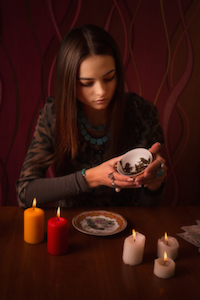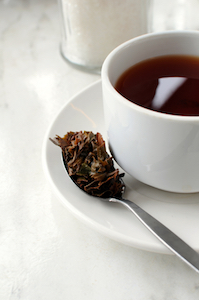Reading Tea Leaves: An Ancient Art Form


One origin story suggests that after sharing a pot of tea, a group of friends discussed their affairs (just like we do today.) Then, someone realized and pointed out that the tea leaves in their cups contained symbols reflecting the topics of their conversation.
But how do you name such a practice? Tea leaf reading is considered the art of tasseography, which also includes reading coffee grounds and wine sedimentation. The name tasseography has linguistic origins in French, with tasse meaning cup, and Greek, with graph meaning writing.
Other historical texts will refer to reading tea leaves as "throwing cups," which could be related to the way excess tea is drained and tossed away before a reading. It likely came about in the Victorian era, after tea was brought to England from China.
The joy of "throwing cups" spanned across nations beginning in the 17th century, thanks to Dutch merchants bringing tea to Europe. England implemented The Tea Act, which restricted access to the delicious beverage to the upper class. This turned the act of throwing cups into a kind of parlor game, exclusive to those who could afford the beverage.
However, thanks to the Scottish botanist Robert Fortune (1812-1880,) other countries were able to easily reap the healthy benefits of tea and analyze the patterns left behind. Fortune smuggled tea plants to Scotland, which allowed even the lower classes to imbibe on a regular basis.
After tea parlors developed in the 1800s, nomadic Romani began performing readings in tea parlors. Following the First World War, it became common for women in the United States to open their own tea parlors, selling light lunches and offering readings to interested customers after a meal.
Tea readings are even depicted in modern literature and movies, such as in "Harry Potter and The Prisoner of Azkaban." Remember when professor Trelawney saw a number of omens in Harry's cup? Professional tea readers can see similar images just as vividly, however most assure that readings contain only positive magic.
It is common for a professional tea leaf reader to discover their love for the practice through a family member, or find that a distant relative was a reader centuries ago. It is a unique form of divination because enjoying the tea is essential to understanding the symbols that form at the bottom of the cup.
Here are the basics of the practice:
1. Start with a white or translucent rounded teacup & saucer, so the tea leaves can be seen; and a teapot that will allow the tea leaves to enter the cup when the tea is poured.
2. High quality loose-leaf tea with full-shaped leaves is essential. A few great teas for reading are Darjeeling, Earl Gray, Jasmine, and Gyokuro.
3. Once the tea is poured it should be enjoyed leisurely. Sugar and milk can be added, but it is advised to go without cream as it can cause the leaves to clump together.
4. Once there are 1-2 teaspoons of liquor left in the cup, the drinker should swirl the tea leaves and take a final quick slurp.
5. Then the drinker should place the saucer on top of the cup, and flip over the cup and saucer as a unit so that the cup is bottom-up on top of the saucer. This will remove any remaining liquid and allow the leaves to spread out.
6. With the cup handle facing the heart of the drinker, they should use their non-dominant hand to turn the cup three times clockwise. Some insist on turning the cup counter-clockwise. When in doubt, turn the cup in the direction that seems less natural. Using the opposite hand and turning the cup is said to connect the left and right sides of the brain, stimulating creative problem solving.
7. The reader should then turn the cup right side up and begin analyzing the leaves—starting from the outer edge of the cup, and moving inwards in a clockwise motion to the bottom center. The portion of the leaves closest to the handle's edge represents the immediate future, and the leaves closer to the center represent several months into the future.
8. The reader may then analyze any symbols or messages found in the cup based on instinct and experience.
While professional tea-leaf-readers can be found throughout the United States and beyond, discovering a love for tea-leaf-reading with friends and family can be a great exercise in creativity. A short guide to symbols can be found here. Think of it as cloud-watching in a cup... with tea!
References
A Highland Seer. Tea-Cup Reading, and the Art of Fortune-Telling by Tea Leaves. Ed. Ruth Hart. April 2006. Retrieved from http://www.gutenberg.org/files/18241/18241-h/18241-h.htm
Gill, Alec. Steeped In Superstition. Web. June, 1 2016. http://www.hull.ac.uk/php/cetag/5jtea.htm
Ed. Meldon, Gordon J. The Encyclopedia of Occultism & Parapsychology, Fifth Edition, Vol. 2. 2001. Retrieved from http://www.eso-garden.com/specials/encyclopedia_of_occultism_and_parapsychology_1.pdf
The Irish Builder: Architectural, Archaological, Engineering, Sanitary, Arts, and Handicrafts. Vol 17. 1875. Dublin. Pg 62, 72. Retrieved from https://books.google.com/books?id=IlNJAQAAMAAJ&dq=fortune+telling+tea&source=gbs_navlinks_s
Plant Explorers. Robert Fortune (1812-1880). Retrieved from https://www.plantexplorers.com/explorers/biographies/fortune/robert-fortune.htm
